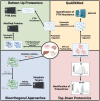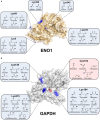A global view of the human post-translational modification landscape
- PMID: 37610048
- PMCID: PMC10586784
- DOI: 10.1042/BCJ20220251
A global view of the human post-translational modification landscape
Abstract
Post-translational modifications (PTMs) provide a rapid response to stimuli, finely tuning metabolism and gene expression and maintain homeostasis. Advances in mass spectrometry over the past two decades have significantly expanded the list of known PTMs in biology and as instrumentation continues to improve, this list will surely grow. While many PTMs have been studied in detail (e.g. phosphorylation, acetylation), the vast majority lack defined mechanisms for their regulation and impact on cell fate. In this review, we will highlight the field of PTM research as it currently stands, discussing the mechanisms that dictate site specificity, analytical methods for their detection and study, and the chemical tools that can be leveraged to define PTM regulation. In addition, we will highlight the approaches needed to discover and validate novel PTMs. Lastly, this review will provide a starting point for those interested in PTM biology, providing a comprehensive list of PTMs and what is known regarding their regulation and metabolic origins.
Keywords: acetylation/deacetylation; acylation; glycation; mass spectrometry; methylglyoxal; post-translational modification.
© 2023 The Author(s).
Conflict of interest statement
The authors declare that there are no competing interests associated with the manuscript.
Figures




Similar articles
-
An emerging field: Post-translational modification in microbiome.Proteomics. 2023 Feb;23(3-4):e2100389. doi: 10.1002/pmic.202100389. Epub 2022 Oct 26. Proteomics. 2023. PMID: 36239139 Review.
-
Identification, Quantification, and Site Localization of Protein Posttranslational Modifications via Mass Spectrometry-Based Proteomics.Adv Exp Med Biol. 2016;919:345-382. doi: 10.1007/978-3-319-41448-5_17. Adv Exp Med Biol. 2016. PMID: 27975226 Review.
-
Comprehensive Protocol to Simultaneously Study Protein Phosphorylation, Acetylation, and N-Linked Sialylated Glycosylation.Methods Mol Biol. 2021;2261:55-72. doi: 10.1007/978-1-0716-1186-9_5. Methods Mol Biol. 2021. PMID: 33420984
-
Status of large-scale analysis of post-translational modifications by mass spectrometry.Mol Cell Proteomics. 2013 Dec;12(12):3444-52. doi: 10.1074/mcp.O113.034181. Epub 2013 Nov 1. Mol Cell Proteomics. 2013. PMID: 24187339 Free PMC article. Review.
-
Post-translational modifications and mass spectrometry detection.Free Radic Biol Med. 2013 Dec;65:925-941. doi: 10.1016/j.freeradbiomed.2013.08.184. Epub 2013 Aug 31. Free Radic Biol Med. 2013. PMID: 24002012 Review.
Cited by
-
Role of UFMylation in tumorigenesis and cancer immunotherapy.Front Immunol. 2024 Aug 23;15:1454823. doi: 10.3389/fimmu.2024.1454823. eCollection 2024. Front Immunol. 2024. PMID: 39247188 Free PMC article. Review.
-
In Silico Analysis of the Missense Variants of Uncertain Significance of CTNNB1 Gene Reported in GnomAD Database.Genes (Basel). 2024 Jul 24;15(8):972. doi: 10.3390/genes15080972. Genes (Basel). 2024. PMID: 39202333 Free PMC article.
-
Decoding the Role of O-GlcNAcylation in Hepatocellular Carcinoma.Biomolecules. 2024 Jul 25;14(8):908. doi: 10.3390/biom14080908. Biomolecules. 2024. PMID: 39199296 Free PMC article. Review.
-
Comprehensive Overview of Bottom-Up Proteomics Using Mass Spectrometry.ACS Meas Sci Au. 2024 Jun 4;4(4):338-417. doi: 10.1021/acsmeasuresciau.3c00068. eCollection 2024 Aug 21. ACS Meas Sci Au. 2024. PMID: 39193565 Free PMC article. Review.
-
Identifying an Abnormal Phosphorylated Adaptor by Viral Kinase Using Mass Spectrometry.Methods Mol Biol. 2025;2854:29-34. doi: 10.1007/978-1-0716-4108-8_4. Methods Mol Biol. 2025. PMID: 39192115
References
Publication types
MeSH terms
Grants and funding
LinkOut - more resources
Full Text Sources
Miscellaneous

